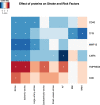Systematic Mendelian randomization using the human plasma proteome to discover potential therapeutic targets for stroke
- PMID: 36253349
- PMCID: PMC9576777
- DOI: 10.1038/s41467-022-33675-1
Systematic Mendelian randomization using the human plasma proteome to discover potential therapeutic targets for stroke
Abstract
Stroke is the second leading cause of death with substantial unmet therapeutic needs. To identify potential stroke therapeutic targets, we estimate the causal effects of 308 plasma proteins on stroke outcomes in a two-sample Mendelian randomization framework and assess mediation effects by stroke risk factors. We find associations between genetically predicted plasma levels of six proteins and stroke (P ≤ 1.62 × 10-4). The genetic associations with stroke colocalize (Posterior Probability >0.7) with the genetic associations of four proteins (TFPI, TMPRSS5, CD6, CD40). Mendelian randomization supports atrial fibrillation, body mass index, smoking, blood pressure, white matter hyperintensities and type 2 diabetes as stroke risk factors (P ≤ 0.0071). Body mass index, white matter hyperintensity and atrial fibrillation appear to mediate the TFPI, IL6RA, TMPRSS5 associations with stroke. Furthermore, thirty-six proteins are associated with one or more of these risk factors using Mendelian randomization. Our results highlight causal pathways and potential therapeutic targets for stroke.
© 2022. The Author(s).
Conflict of interest statement
J.M.M.H., L.C., M.T. and E.Y.-D. became full-time employees of Novo Nordisk Ltd. during the drafting of this manuscript. J.D. serves on scientific advisory boards for AstraZeneca, Novartis and UK Biobank, and has received multiple grants from academic, charitable and industry sources for the submitted work. A.S.B. reports institutional grants from AstraZeneca, Bayer, Biogen, BioMarin, Bioverativ, Novartis, Regeneron and Sanofi and personal fees from Novartis. P.G.B. is a full-time employee of Biogen Inc. The remaining authors declare no competing interests.
Figures







References
Publication types
MeSH terms
Substances
Grants and funding
LinkOut - more resources
Full Text Sources
Medical
Research Materials
Miscellaneous

